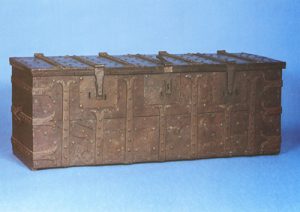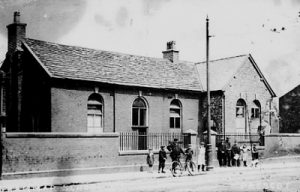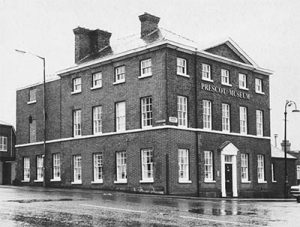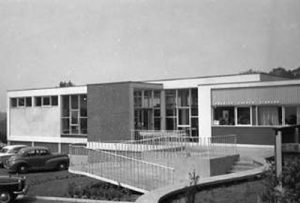Prescot is believed to be Anglo-Saxon in origin, with the name ‘Prescota‘ – meaning a ‘priest cottage’. It was the centre of an extensive parish, within the West Derby Hundred which included fourteen other townships including St Helens.
In 1333 the Lord of the Manor, William D’Acre, was granted the right to hold a weekly market and the town’s importance is reflected in its inclusion on the Bodleian Map of Britain drawn by Gough in 1350. The manor was sold in 1391 to John of Gaunt and on his death passed to his son, who subsequently became Henry IV. In 1447 Henry VI included both the Manor and Rectory of Prescot as gifts to establish a college at Cambridge University [subsequently King’s College]. The Royal Charter gave the people of Prescot exemption from paying certain tolls, it also gave them a degree of self-government and the town adopted the college crest as its own. Due to the distance from Cambridge the daily running of the town was left to the Steward, his appointed deputy and the Court Leet (the local town council).

The list of rectors for St. Mary’s church goes back to 1179, with much of the present church fabric dating to 1610. One of those making a large donation enabling the church to be rebuilt was John Ogle of Whiston, and when he died in 1614 his effigy was placed in the new church. The church also contains a number of items from earlier buildings including a fifteenth century vestry, intricate woodcarvings and panelling and an Anglo-Saxon font. The tower and spire, added in the late 1720s, is thought to be the work of a pupil of Sir Christopher Wren. There is also an 18th Century marble font, in which the distinguished actor John Philip Kemble was baptised in 1757.
The establishment of a number of potteries in the fourteenth century, the earliest recorded in the region, was to provide an important stimulus to the town. A survey conducted in 1592, by King’s College Cambridge, detailed the existence of seven kilns in the town. These kilns would have dominated the landscape, and were centered around the Eccleston Street area. The town developed a reputation for producing fine pottery, using a mixture of the local white and red clays, numerous examples of which can be found in the town’s museum. Another impetus was the accessibility of rich seams of coal close to the surface, which was mined from the early sixteenth century, with much of the coal produced being destined for Liverpool. A Newcomen Engine was installed in 1746, between the Hall Lane (now High Street) and Warrington Road area, to pump-out water from the mine. It continued to prosper until the construction of the Sankey Canal in 1767 broke the town’s monopoly of supply to the city.
Whilst copyholders were entitled to dig the coal on their land, the main mine was at Prescot Hall which lay at the bottom of Hall Lane. In the mid-sixteenth century this was let by the Layton family who built a new Hall in 1562 which was described a few years later as having; ‘a dining hall, kitchen and several bedrooms together with two barn stables.’ The house was over time, extended and rebuilt and was eventually demolished in the 1930s.
The town roads were greatly enhanced by the Turnpike Trust of 1726 between Liverpool and St. Helen’s. Prescot was a major point along the route which split into two on Church Street; one to St. Helens (via the High Street and St. Helen’s Road), the other to Warrington (via Market Place and Kemble Street). Although the Liverpool-Manchester railway, the world’s first passenger service, was opened in 1830 and stopped at nearby Huyton it was not until 1871 with the construction of a branch-line between Huyton and St. Helens that Prescot gained its own railway station. This was followed thirty years later with it’s first tramlines which followed the established routes to both St. Helens and Warrington.

Considerable changes to the town occurred in 18th Century with the continued growth of a number of craft industries especially watchmaking, toolmaking and the potteries, resulting in increased prosperity and a rapid rise in population from an estimated 700 in the 1690s to 3645 in 1801. The town was practically rebuilt from the 1750s including the construction of a number of fine Georgian houses, some of which have survived to the present day. A further indication of it’s growth was the revival of the Court Leet, which was based in the new Town Hall built in 1755, which bore the statue of Our Lady Bountiful on its roof as a testimony to the town’s new found wealth. The door lintel from the town gaol, built adjacent to the Town Hall, was used as a test of literacy for those wishing to hold office. This Alphabet Stone, an 18th Century sandstone block contains all the letters of the alphabet (minus the “J”, which was not in use at the time).

The Court Leet was adapted to include taxes for street improvements and for caring for the poor of the town, and it’s records were stored in the town chest which is held today by Prescot Museum. The Court Leet enabled some people to play a vital role in shaping the town. One such individual was John Wyke, a watchmaker by trade, who held a number of positions including constable and overseer of the poor. Although he moved his business to Liverpool in 1761, when he died in 1787 he left his money and his library for the education of the poor in Prescot and was buried in Prescot churchyard.
Watches were first produced in the sixteenth century in Germany and were quickly imitated. Watchmaking was introduced into Prescot by a Huguenot refugee from France called Woolrich. The skills were easily picked-up by the town’s blacksmiths, with the work being carried out in houses. In 1795 John Aiken said of Prescot that ‘the town produces the best in the world.’ The town had hundreds of small workshops where either parts were made, or where watches were constructed from parts organised within an assembly tray.
The rebuilding of the town continued throughout the nineteenth century. The growth in population continued during this century with the census for 1851 revealing that nearly a quarter of the population was born in Ireland, a legacy of the famine which had driven many to emigrate. In the 1860s the Round House, which had been built in 1812, was replaced by the Market Hall. Unfortunately the crafts which had flourished during the previous century were very much dependant upon skilled craftsmen, thereby not able to compete with those employing the latest mass production techniques. The potteries declined rapidly due to the cheaper porcelain produced in Staffordshire.

Faced with a similar situation, the Lancashire Watch Company was founded in 1889. This company sought to put the skilled workers (relating to all of the processes involved in the manufacturing of watches) under one roof. Unfortunately long-term it was unable to compete against American and Swiss manufacturers and finally closed in 1910. A few craftsmen remained in the town until the 1960s, but the only surviving remnants to be found today are the characteristic gallery windows still dotted around the township.
During 1891, a company was formed that changed the industrial landscape of Prescot for a hundred years. Joseph and Jacob Atherton established the British Insulated Wire Company that manufactured paper insulated cables in Britain under licence from the patent owner’s company in America. The following year they installed electric street lighting in Prescot and lighting inside Knowsley Hall, the ancestral home of the Earls of Derby.

The company expanded rapidly and mergers took place during the following 50 years. Firstly in 1902, the company merged with the Telegraph Manufacturing Company of Helsby and became British Insulated and Helsby Cables Limited and in 1925, the firm was renamed British Insulated Cables Limited. The final merger in 1945 was with a company called Callender’s of Erith and the business then became known as British Insulated Callender’s Cables (abbreviated to BICC) employing numerous workers not only from within Prescot but all the surrounding townships as well. The main BICC factory in Prescot closed in early 1990s with smaller premises sold-off to other companies.
Since medieval times the market and church formed the focal point of the town, and evidence of this can still be found by studying it’s road patterns. The routes have remained basically unchanged for centuries however, they have, through necessity, been widened considerably in order to carry an ever-increasing volume of traffic. Derby Street, High Street and Eccleston Street all radiating from the centre of Prescot to its surrounding townships and beyond.


When Prescot was presented with an ornate war memorial by Councillor William John Lucas, chairman of the Prescot Urban District Council, it was a significant event (the first public memorial in the township) and was attended by large crowds. It was very unusual for a war memorial to be erected during a conflict but in Prescot’s case unveiling took place on 9th September 1916 which turned out to be mid-way through the Great War.
The memorial was originally located in Market Place but ultimately the later increase in motor vehicle traffic and a need for road alterations forced a re-location to the plateau adjacent to the parish church where it remains today.
A further Great War memorial was unveiled in the district on 23rd July 1922 at Eccleston Lane Ends (on the corner of St Helens Road and Burrows Lane). The memorial, which commemorates the men from the West Derby Hundred of the County Palatine of Lancaster was commissioned by Frederick Richard Dixon-Nuttall whose army-officer son was one of those killed during that war.
The Court Leet, which had established the principals of local self-government, was replaced in 1867 by the newly-created Prescot Local Government Board. This became the Prescot Urban District Council after further re-organisation in 1895 and subsequently in 1974, Prescot became one of the local townships to come under the umbrella of the newly formed Knowsley Metropolitan Borough Council.
Prescot Grammar School, which was founded in 1544 in the will of Gilbert Latham (the Archdeacon of Man), occupied a number of sites within the town including that of Church Street (1592-1760), High Street (1760-1924) and St Helen’s Road (1924-1992). The School was granted its own Coat of Arms in 1933 and in 1955, Prescot Girl’s Grammar School on Knowlsey Park Lane was opened with the two schools being amalgamated in 1975.


Examples of the historical local craft industries of clock and watchmaking, toolmaking, the pottery industry and later 19th Century wire production were widely featured when Prescot Museum opened its doors in 1982 (located on the corner of Church Street in the former Westminster Bank building) just across the road from Prescot Branch Library which was opened by Lancashire County Council in 1961.


In recent times, changes to shopping habits brought about the construction of the Cables Retail Park and as the name suggests it was built on the factory site of the former cable manufacturer BICC. The new retail park brought major names to the area including Tesco Extra, Next, Argos, Carphone Warehouse, Boots and McDonald’s.
Around the same time, centralisation of council services within townships was introduced across the borough and in Prescot this took place at Prescot Shopping Centre, Aspinall Street, which had originally opened in 1989. The regenerated site was augmented in 2012, with a new Prescot Library, Museum and a One-Stop-Shop providing a multi-purpose facility in one building adding to the existing shopping units – all with easy access and parking. Another new build to appear around this time (opening in 2014) was the modern Prescot Town Hall, built on the former site of The Fusilier public house which had opened there in 1981 (on the site of the even earlier 18th Century public house, The King’s Arms).

Educational trends brought new ‘centres for learning’ to Knowsley Borough, the final one of the seven centres was established in 2009 at Prescot, called Knowsley Park School, a co-educational secondary school that followed a merger between Prescot School and Knowsley Higher Side
As a replacement to both the old Police Station on Derby Street, and the closure of Whiston and Huyton’s fire stations, a new purpose-built Prescot Community Fire and Police station opened in January 2018 on Cables Way following a 12-month build and fitting-out period.
Prescot’s shopping area has taken on a new modern look in recent years with the opening of a variety of food and drink premises. During 2018, The Bard, a micropub opened on High Street, both the Pinion Bistro restaurant, and the Balearic Bar Urbano Chirinquito opened on Eccleston Street and Down in Albion, a coffee shop and tearoom began business in Atherton Street. The trend continued through 2019 with four new premises opening in Eccleston Street alone: The Oven Pizzeria; Spice Chilli, Indian restaurant; Harrington’s Bar and Eatery and Poco Bar and Café. Also that year, the Lord Strange, bar and restaurant started in Leyland Street and the Imaginarium Bistro opened in Market Place. This was followed in February 2020 by the new Eden Bar and Garden in Eccleston Street.
Further improvements to Prescot town centre continue with the forthcoming building of the Shakespeare North Playhouse, a 350 seat Jacobean theatre and education centre which is due to open in 2022. In 2018, a competition was held to find a name for the official street address of the new theatre: the winner being ‘Prospero Place‘, inspired by the main character’s name in Shakespeare’s play ‘The Tempest.’ As the work on the theatre site progresses, a huge 190-foot high tower crane was erected in January 2020 to aid the heavy construction work.
An announcement was made in June 2020 stating that Knowsley was to become the Liverpool City Region’s Borough of Culture in 2022. This ties in nicely with the proposed opening of the Shakespeare North Playhouse due during the summer.
A new £3 million regeneration project the Prescot High Street Heritage Action Zone was confirmed in July 2020 after Knowsley Council with the support of Historic England gained government funding worth £1.5 million toward the total cost. The project which runs until 2024 includes the repair and restoration of a number of Prescot’s older buildings. Prescot’s first cinema building on Kemble Street originally called Prescot Picture Palace and Theatre of Varieties is to be transformed back into a cinema. The former picture house (which opened in 1912 and closed in 1957), was in recent times occupied by the Prescot Community Church but it remains an important building due to the survival of its original auditiorium and many architectural features, so much so, that it has recently been granted Grade II listed status by English Heritage (in May 2021). Another restoration will be to the Grade II listed townhouse building in Church Street that became a bank and later still was the home of Prescot Museum. This building is now to become a site for creative arts and crafts.
The Coronavirus pandemic in 2020 dominated the news for the whole year. A timeline of the events that occurred can be consulted here: COVID-19 National and Local timeline 2020
Continuing with the transformation of Prescot’s town centre, the first half of 2021 has already shown many improvements in the area. New signage has been installed in the form of 11 fingerposts and 10 monoliths to aid visitors navigate around the town and to easily find locations, transport links and buildings of historical status. The monoliths contain maps of the town centre together with historical photographs depicting Prescot’s heritage of watch making and cable manufacture. A series of colourful signs depicting the slogan ‘Welcome Wanderer‘ combine this heritage with Shakespearian quotes that merge the past to the future of the town. These signs are positioned on the approach roads into Prescot and are complimented by the recent addition of three colourful public art works positioned on the roundabouts – gateways to the town itself.
Completion of 12 months work at Prescot Railway Station was celebrated on 11th June 2021 by the unveiling of a commemorative plaque by Metro Mayor Steve Rotheram. The major works included a new lift shaft to each platform, a refurbished modern ticket office, step-free easy access from the car park to the platforms and improved facilities including new platform seating, a platform shelter and the installation of enhanced lighting and signage.
Prescot along with five other towns has also been selected to become part of the three-year national cultural project ‘Picturing England’s High Streets‘ which will run until 2024. The two photographers confirmed for the task will start work in July 2021 and will liaise with members of the local community and local organisations to provide a contemporary portrait of the town’s high street over the period.
Having been used for the last 20 months in the construction of the Shakespeare North Playhouse, the 190-foot tower crane that had temporarily been part of Prescot’s skyline, was dismantled and removed from the site in mid-September.
The Elizabethan Fayre returned to Prescot on Saturday 23rd October offering a range of family activities including children’s face painting, candle making and mask making, circus skills workshops and the popular ‘birds of prey’ stand. Additionally, a ‘storytelling’ event took place where local people shared their memories of growing up in Prescot in their youth. The Elizabethan Fayre will return again in 2022.
An event in Prescot town centre on Saturday 13th November saw the Christmas lights switched on and also featured live music and walkabout entertainment from 4pm-7pm.
The annual remembrance ceremony resumed this year on Sunday 14th November and began with a parade from Prescot Primary School, Maryville Road, at 10.25am, arriving at the cenotaph on the plateau outside the parish church at 10.50am where the outdoor service took place and included the laying of wreaths. This was followed by an indoor service at St Mary’s Parish Church. The parade then returned to Prescot Primary School around noon.
The fourth and final piece of the Prescot Gateway public artwork has been installed outside Prescot Railway Station. The artwork designed by artist Martin Herron celebrates Prescot’s industrial past.
As the Coronavirus pandemic continued in 2021 with new variants appearing, a further timeline shows the changing situation throughout the year: COVID-19 National and Local timeline 2021
Prescot-born Sir George Howarth, M.P. for the Knowsley Constituency received the honour of Freedom of the Borough at a Knowsley Council meeting on 23rd March 2022. The long-serving Labour M.P. began his political life as a councillor for Huyton-with-Roby Urban District Council in the 1970s, before becoming an M.P. in 1986.
To celebrate Knowsley as this year’s Borough of Culture, Prescot’s popular Elizabethan Fayre was extended to cover two days and took place on Saturday 7th and Sunday 8th May.
Following the completion of building construction and the internal fit out at The Shakespeare North Playhouse, the doors opened with a planned weekend of festivities on 15th-17th July. The opening season at the theatre contains performances of A Midsummer Night’s Dream and will also showcase established local talent with evenings by Liverpool screenwriter Jimmy McGovern and comedian Johnny Vegas. Tickets can now be booked for the opening season by accessing the Shakespeare North Playhouse website
The success of the UK’s vaccination programme meant that coronavirus restrictions were eased in 2022. A summary of COVID-19 information for the year can be found here: COVID-19 National and Local timeline 2022
Knowsley Council recently submitted three bids for funding under Round 2 of the Government’s Levelling Up Fund – one each for the townships of Prescot, Halewood and Huyton. One of the bids was for £8 million to restore and reopen Prescot’s Picture Palace cinema in Kemble Street which had recently gained Grade II Listed status. A government announcement on 18th January 2023 listed the successful applicants: unfortunately, both the Prescot and Huyton bids failed to gain any funding but the bid for Halewood township was successful and was awarded £15.3m.
Prescot’s Shakespeare North Playhouse has been named as Theatre Building of the Year at this year’s The Stage Awards.
The UK Government’s Emergency Alerts System is now live and will be used to warn people when lives are in danger, initially to warn of severe weather-related incidents including flooding and provide instructions how to respond to an alert. To check the system, a test took place at 3pm on Sunday 23rd April whereby most people received an official text message on their mobile phones.
The latest COVID-19 information can be found here: COVID-19 National and Local timeline 2023 (to end of May 2023)
Prescot’s popular Elizabethan Fayre returns to the town centre on 10 June. This free event from 11am-5pm includes theatre, music, dance, craft workshops and heritage walks
